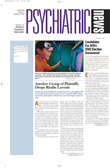In 1994, a Wyoming native—“Tom”—was hiking in the backcountry of Yellowstone National Park when an 800-pound grizzly bear tackled him and started gnawing on his skull. Tom’s hiking partner saved his life, but for months afterward Tom had recurring nightmares about the grizzly attack.
Tom could probably have profited from a technique called imagery-rehearsal therapy, in which a person changes the scenario of a recent nightmare any way he or she wishes, writes down the improved version, then mentally rehearses it in a relaxed state. Such therapy can reduce nightmares experienced by persons with posttraumatic stress disorder, a study reported in the August 1 Journal of the American Medical Association suggests.
The investigation was conducted by University of New Mexico School of Medicine researcher John Lauriello, M.D., assistant professor and acting chair of the psychiatry department, along with colleagues in New Mexico, Arizona, and Canada.
During the 1980s and early 1990s, some researchers noted that imagery-rehearsal therapy seemed to help a few people suffering from chronic nightmares. So Lauriello and his team decided to conduct a study to see whether the technique might benefit individuals diagnosed with posttraumatic stress disorder, since such persons often suffer from nightmares. Indeed, nightmares are one of the hallmarks of the disorder.
Their subjects were 114 women diagnosed with PTSD. Whereas most had been victims of sexual assault as adults, a fair number had also been sexually abused during childhood or adolescence. Of the 114 subjects, 54 received imagery-rehearsal therapy during the three-week study, and 60 served as controls during the same period. There were no significant differences between the two groups as to whether they were receiving psychological help or psychotropic medications for their PTSD at the start of the study. About 79 percent of the 114 subjects were receiving psychological help (primarily counseling) and/or psychotropic medications (primarily tricyclic antidepressants or selective serotonin reuptake inhibitors).
The 54 subjects receiving imagery-rehearsal therapy underwent three weekly sessions over the three-week period of the study. During the first session, they were asked to explore the possibility that, although nightmares may be trauma-induced, they may also be habit-sustained, and to practice some pleasant-imagery exercises. During the second session, they learned how to use imagery-rehearsal therapy on a single, self-selected nightmare and were instructed to continue using it during the following weeks on various nightmares that troubled them. During the third session, they came together to discuss progress with the technique, to share experiences with it, and to discuss whether the technique might be useful for countering other PTSD symptoms other than nightmares.
Both three and six months after the three-week study was over, the researchers contacted all 114 subjects to learn how they were faring as far as nightmares were concerned. Controls reported that they were experiencing somewhat fewer nightmares than they had experienced at the start of the study, but the difference was nonsignificant statistically. In contrast, subjects who had used imagery-rehearsal therapy reported a substantial reduction in the number of nightmares they were experiencing compared with when the study started, and this difference was highly significant statistically. For instance, whereas controls experienced nightmares on the average of 3.68 nights a week at the start of the study, they were still experiencing them on the average of 3.28 nights a week at three or six months after the study. Treated subjects had experienced nightmares on the average of 3.88 nights a week at the start of the study, yet were experiencing them on the average of only 1.33 nights a week at the three- and six-month follow-ups.
Also of interest, subjects who had used image-rehearsal therapy to counter nightmares reported that it had not just reduced the number of nightmares they were having, but also helped them reduce some of the PTSD symptoms—for example, intrusive thoughts or emotional arousal. One reason may have been because some of the subjects used imagery-rehearsal therapy not just to counter nightmares, but to improve their mental states while awake. For instance, one participant used the therapy to develop more positive images because she believed that she had a tendency to think negatively. Another reported that she used the therapy to gain a feeling of control over daytime moods and to correct negative or obsessive thoughts.
“To our knowledge,” the researchers noted, “this is the first randomized, controlled study demonstrating that improvement in PTSD symptoms with a nightmare-focused intervention is both substantial and sustained at six-month follow-up; these changes in posttraumatic stress were comparable to a recent PTSD-treatment study using sertraline.”
What is now needed, the researchers wrote, are studies that compare the treatment value of imagery-rehearsal therapy for PTSD with the treatment value of psychotropic medications for the disorder. Studies should also explore whether giving imagery-rehearsal therapy and psychotropic medications together to PTSD patients is more effective than giving either modality alone, the investigators contended.
The article “Imagery Rehearsal Therapy for Chronic Nightmares in Sexual Assault Survivors With Posttraumatic Stress Disorder” can be accessed on the Web at www.jama.ama-assn.org by clicking on “Past Issues” and then “August 1, 2001.” ▪
